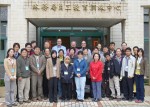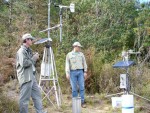A gathering of giant green snakes? A huge spider towering over us? Not really, just a tangled mass of roots and stems, each enshrouded in a thick layer of green moss, that surrounded us as we hiked down to Yuan Yang Lake (YYL) in north central Taiwan (see the July 2005 BioScience cover for more photos). Surrounded by ancient cypress (some thousands of years old) and fed by cloud water and typhoons, the thick, verdant forest seems an odd place for a US LTER Information Manger to be! However, YYL is the site of one of an increasing network of wirelessly-connected buoys studying lake metabolism (http://gleon.org), and my visit there was part of a growing collaboration between individual LTER sites and the Taiwan Ecological Research Network (TERN).
At the 2003 LTER All Scientists Meeting (ASM), several U.S. LTER sites were asked to host a day trip by Taiwanese researchers to discuss information management. In February 2004 they made a whirlwind tour of LTER sites (including CAP, NTL, SEV, VCR and the LTER Network Office). It was clear that this was a group that was actually interested in developing information management systems and not just talking about them. As a follow-up to that trip, TERN information managers Sheng-Shan Lu, Meei-ru Jeng, Chien-Wen Chen, Chi-Win Hsaio, and Chau-Chin Lin each spent three months working at either NTL or VCR between the fall of 2004 and spring of 2007 learning the detailed practice of information management as conducted at these sites and collaborating on the development of new tools.
For example, Sheng-Shan Lu spent three months during the fall of 2004 at NTL. His primary focus was to learn as much as possible about Ecological Metadata Language (EML) and the various methods and tools a site could use to implement EML. He input metadata from one of his projects from Taiwan into the NTL database in order to explore and understand the relational database model NTL uses for its metadata and how the metadata are used to drive dynamic database access on the NTL website. Thus, Sheng-Shan participated in the creation and population of the EML taxonomic module for NTL datasets-a major undertaking. While at NTL, he learned other ways of managing EML, including Morpho, Metacat, and the Florida Coastal Everglades Excel-template system. In addition, he took advantage of the opportunity to learn about the many other aspects of the NTL information management system.
An important aspect of these extended visits was that it allowed time for real collaborations to develop. For example, while visiting VCR, Chi-Win Hsiao developed online tools that take an EML document and the associated data as input, performs quality assurance analyses, and provides an online statistical interface (http://eml.twecoinformatics.org/). These tools can be used at any LTER site because they use standardized EML metadata as input. TERN has subsequently used the tools to cross check all their metadata against the underlying data. These interactions were supported in part by Bill Chang of the NSF's International Programs office, who provided a supplement to the VCR-LTER grant.
U.S. Information Managers Barbara Benson (NTL), Don Henshaw (AND), Peter McCartney (CAP) and John Porter (VCR) have all participated in workshops with the TERN "IM Team" focusing on the use and development of metadata and LTER information management (IM) systems, and in IM workshops involving participants from the entire East Asia Pacific (EAP) region of the ILTER network.
Prior to the 2006 LTER IM and All-Scientists Meeting, Taiwan information managers Meer-ru Jeng, Fu-Ching Yang, and Yunyin Yeh made brief visits to several LTER sites in the northeast. They met with information manager Jonathan Walsh at BES and toured meteorological stations at the Institute for Ecosystem Ecology. They then traveled to HFR to meet with information managers Emery Boose and Julie Pallant and on to Hubbard Brook to meet with information manager John Campbell. At each site they learned about the methods each site was using for managing its data, and more importantly, the philosophies that underlie each system. The team then traveled to Estes Park, CO to attend the 2006 ASM.
ILTER chair Hen-biau King of the Taiwan Forestry Research Institute (TRFI) has been a strong supporter of our information management efforts. Taking the lead for TERN is Chau-Chin Lin, who has assembled a strong IM team, including specialists in web, PHP programming, spatial,databases, and relational databases. The TERN team was the first group worldwide to get Metacat software to operate on Windows-based server and have devoted substantial efforts to resolving language and character-set issues in MORPHO and EML. TERN has also held over 20 workshops to teach researchers how to develop and use EML documents.
The TERN group is currently working on several collaborations with U.S. and regional ILTER sites, including lake ecology with NTL, agroecosystem ecology with KBS, developing links to the CLIMDB system with AND, and wireless sensor networks with the VCR. Additional workshops in Taiwan and Korea are being planned for 2007.
An important outcome of these interactions is that several ILTER groups are developing world-class expertise in ecological information management. Although the US LTER program had a head start, the TERN group and others are developing at a rapid pace. Just as the U.S. network has benefited from intersite interactions, we are now at a point where we can similarly benefit from international collaborations. Many hands truly do make "light work!"
John Porter, with help from Barbara Benson and Chau-Chin Lin.

 Enlarge this image
Enlarge this image



